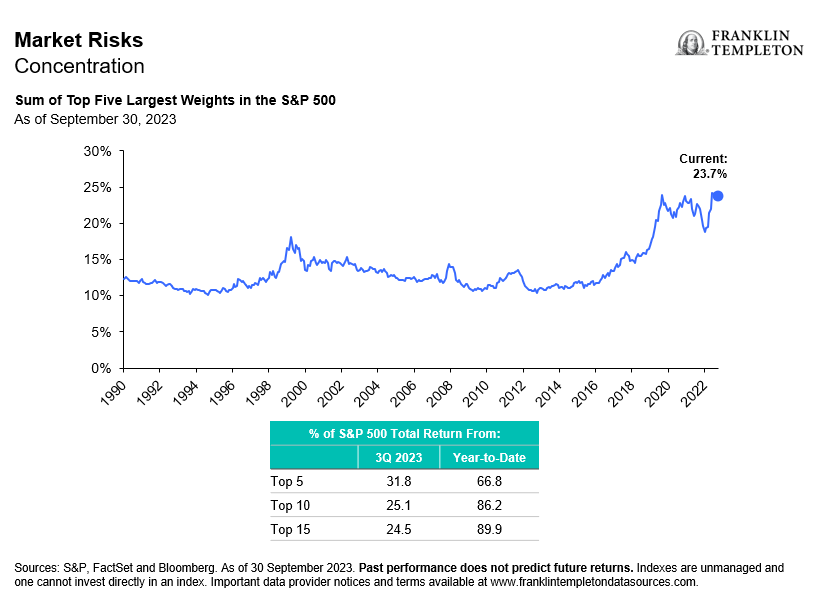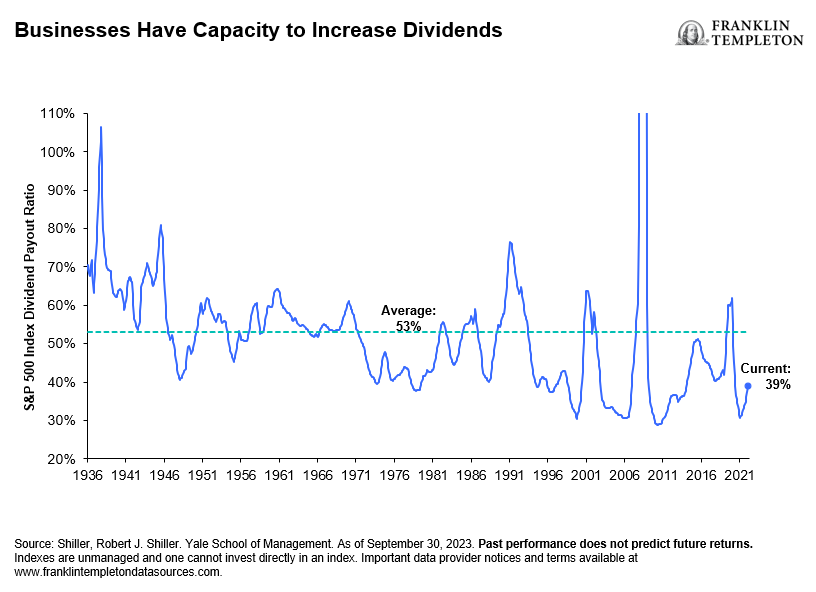Key takeaways
- Although US equities have performed well so far in 2023, there has been a narrow leadership from the so-called “Magnificent Seven” companies (Amazon, Apple, Alphabet, Meta, Microsoft, Nvidia and Tesla).
- In addition to strong participation in up markets, our strategy focuses on risk mitigation in uncertain markets, preferring stocks of companies that can withstand economic fluctuations.
- We do not aim to solely maximize upfront yield but focus on a balance of current yield and growth of yield. In an inflationary environment, income growth is crucial for protecting purchasing power.
Resilient US economy with narrow leadership in equities
Throughout 2023, investors expected that the United States would be in a recession and the US Federal Reserve (Fed) would begin to cut interest rates in the back half of the year. Yet, not only did the Fed not cut rates, it also raised them. Third-quarter 2023 economic growth was the strongest on record. Thus, macroeconomic conditions have evolved and remain fluid.
US equities, as measured by the S&P 500 Index, have performed strongly so far in 2023. However, there has been a narrow leadership by the so-called Magnificent Seven stocks: Amazon, Apple, Alphabet, Meta, Microsoft, Nvidia and Tesla.
As of September 30, 2023, the Magnificent Seven represented around 25% of the market capitalization of the S&P 500.1 Only two out of these seven, Apple and Microsoft, pay dividends.2
In our analysis, there will likely be a mild US recession in 2024 and the Fed will keep rates elevated for a longer period of time than the market expects. We also believe that US equity valuations are still too high and will likely decline as the Fed continues to battle inflation.
Risk mitigation in uncertain markets
We do not concentrate on macroeconomic data, however, and instead design our portfolio to do well in different environments, which can include unanticipated inflation, deflation, economic growth, recession, and high and low interest rates. We prefer stocks of companies we believe can ride out economic storms.
Among other things, our strategy aims to provide risk mitigation in bearish and more volatile markets. Our approach is to invest in companies with strong balance sheets, low levels of leverage, durable revenue streams, high returns on invested capital and wide competitive moats that we believe can weather challenging market conditions.
While periods of rising markets lift returns for all assets, the underlying conservatism of our strategy means it will tend to lag in very hot markets like the one we have seen in 2023.
On the flip side, the deeper the correction in equity markets, the more risk mitigation we believe we can offer. In short, our strategy is not as growth-oriented as the S&P 500, but not as value-oriented as our peers.
A focus on income and growth of income
Another hallmark of our strategy is that we don’t design our portfolio solely around maximizing upfront yield; instead, we seek a balance of upfront yield and growth of yield. We believe it is important to discover how companies translate their earnings and cash flow growth into income growth for their shareholders.
Recent high inflation has served as a stark reminder of how important income growth is in protecting purchasing power in an inflationary environment. We focus on income growth partly because we don’t know how inflation will evolve in the future.
The current yield and growth of yield combination we seek can also include variable dividends. In addition to paying a base dividend, for example, a company might pay an additional variable dividend when times are especially good.
In 2022 when prices rose for commodities like oil and gas, some energy companies rewarded shareholders with a higher level of variable income because the cash flows of companies in this space were greater. As commodity prices fluctuate, these companies can reduce the variable dividend without impairing the base dividend they pay.
Even without these variable dividends, and even if a recession happens in the United States, it is our view that companies’ payout ratios won’t be severely impacted and could still grow.
Conclusion
In summary, our aim is to have a portfolio of high-quality, dividend-paying stocks that can deliver strong risk-adjusted returns through a combination of yield and growth of income.
WHAT ARE THE RISKS?
All investments involve risks, including possible loss of principal. Equity securities are subject to price fluctuation and possible loss of principal. Dividends may fluctuate and are not guaranteed, and a company may reduce or eliminate its dividend at any time.
Any companies and/or case studies referenced herein are used solely for illustrative purposes; any investment may or may not be currently held by any portfolio advised by Franklin Templeton. The information provided is not a recommendation or individual investment advice for any particular security, strategy, or investment product and is not an indication of the trading intent of any Franklin Templeton managed portfolio.
IMPORTANT LEGAL INFORMATION
This material is intended to be of general interest only and should not be construed as individual investment advice or a recommendation or solicitation to buy, sell or hold any security or to adopt any investment strategy. It does not constitute legal or tax advice. This material may not be reproduced, distributed or published without prior written permission from Franklin Templeton.
The views expressed are those of the investment manager and the comments, opinions and analyses are rendered as at publication date and may change without notice. The underlying assumptions and these views are subject to change based on market and other conditions and may differ from other portfolio managers or of the firm as a whole. The information provided in this material is not intended as a complete analysis of every material fact regarding any country, region or market. There is no assurance that any prediction, projection or forecast on the economy, stock market, bond market or the economic trends of the markets will be realized. The value of investments and the income from them can go down as well as up and you may not get back the full amount that you invested. Past performance is not necessarily indicative nor a guarantee of future performance. All investments involve risks, including possible loss of principal.
Any research and analysis contained in this material has been procured by Franklin Templeton for its own purposes and may be acted upon in that connection and, as such, is provided to you incidentally. Data from third party sources may have been used in the preparation of this material and Franklin Templeton (“FT”) has not independently verified, validated or audited such data. Although information has been obtained from sources that Franklin Templeton believes to be reliable, no guarantee can be given as to its accuracy and such information may be incomplete or condensed and may be subject to change at any time without notice. The mention of any individual securities should neither constitute nor be construed as a recommendation to purchase, hold or sell any securities, and the information provided regarding such individual securities (if any) is not a sufficient basis upon which to make an investment decision. FT accepts no liability whatsoever for any loss arising from use of this information and reliance upon the comments, opinions and analyses in the material is at the sole discretion of the user.
Products, services and information may not be available in all jurisdictions and are offered outside the U.S. by other FT affiliates and/or their distributors as local laws and regulation permits. Please consult your own financial professional or Franklin Templeton institutional contact for further information on availability of products and services in your jurisdiction.
______________
1. Sources: S&P, FactSet and Bloomberg. Indexes are unmanaged and one cannot directly invest in them. They do not include fees, expenses or sales charges. Past performance is not an indicator of future results. See www.franklintempletondatasources.com for additional data provider information.
2 Nvidia pays a very small nominal dividend, yielding 0.03%.



